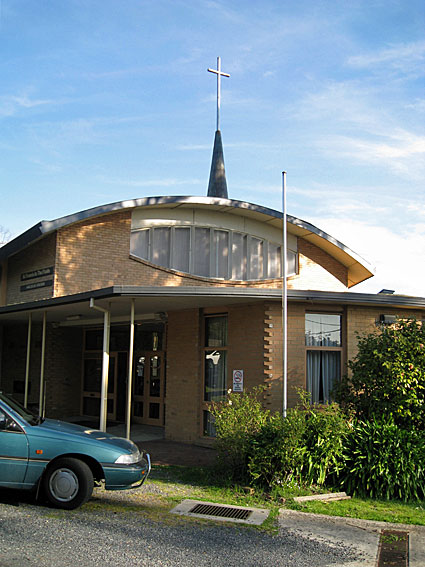
St Francis-in-the-Fields Anglican Church, Mooroolbark
[Photograph by Geoffrey Cox (September 2017)]

St Francis-in-the-Fields Anglican Church, Mooroolbark
[Photograph by Geoffrey Cox (September 2017)]
Historical and Technical Documentation by Geoffrey Cox
© OHTA 2017 (last updated September 2017)
Designed originally by the architect Wystan Widdows as a hall, the foundation stone of St Francis-in-the-Fields Church was laid on 18 February 1962. The church was extended in 1982, when an enlarged hall was relocated to adjoin it.1
The organ was built by William Anderson of Melbourne for St Mark's Anglican Church, Fitzroy, where it was opened with special services on All Saints' Day, 1 November 1877, and on the Sunday following:
Special services were held at St. Mark's Church of England, Fitzroy, on Thursday evening, 1st inst., and Sunday last, 4th inst., in connexion with the opening of the new organ. Some three months ago the vestry decided to purchase a new instrument, and with commendable liberality the congregation and friends at once subscribed the necessary funds. The instrument, which was built by Mr. Anderson of this city, cost £500. It consists of great, swell and pedal organs of full compass, and has 18 stops and 3 composition pedals. The stops to great organ are - open diapason, stopped diapason, dulciana, claribella, flute, principal, twelfth, fifteenth; to swell organ - open diapason, stopped diapason, keraulophon, principal, piccolo, hautboy; bourdon to pedal organ and three couplers, viz., swell to great, pedals to great, pedals to swell. The organ and choir are placed near to the chancel - an improvement on the old position, which was at the back of the church, and behind the congregation. The Rev. R. B. Barlow, incumbent, conducted the services on both occasions. On Thursday evening, Hopkins's service in F was given, and the anthem "All Nations," by Mr. Summers, organist of St Peter's. At the conclusion of the service the "Hallelujah" chorus, from the "Messiah,'' was rendered in fine style, the choir being assisted by the boys of St. Peter's choir. In order to display the capabilities of the organ, the organist of the church (Mr Otto Vogt) gave several selections, amongst which were offertiore in D by Batiste; march, "Roumaine;" triumphal march, by Costa; andante by Lott; march from "Athalie." On Sunday morning the choir rendered Attwood's service in F. The Rev. Mr. Barlow took for his text, Psalms lvii., 8-10 - an appropriate text for the occasion. In the evening, Hopkins's evening service in F was sung, and the anthem "O taste and see how gracious the Lord is." The services throughout were rendered very smoothly, reflecting credit on the choir and the organist.2
In the specification given above, the Stopped Diapason 8ft on the Great can be assumed to have provided a common bass (12 notes) for both the Dulciana 8ft (Ten. C) and the Claribella 8ft (Ten. C). The organ thus contained 14 speaking stops. Comparison with Anderson's organ built in 1879-80 for St Mary's Anglican Church, North Melbourne,
suggests that both the Keraulophon and Hautboy stops on the Swell at Fitzroy also extended only to Tenor C. Unlike the previous two organs at St Mark's, which had been placed at the rear of the church, the Anderson organ was located adjacent to the chancel on the right-hand side.

The William Anderson organ of 1877
[Photograph: State Library of Victoria:
St Mark's Church, Fitzroy: Records, 1847-1982
(MS 11391), Box 1990/MCFB 4].3
It appears that the organ was not maintained as well as it might have been, and that there was damage caused by water coming through the roof. George Fincham wrote to the church in January 1892, and again in February 1895, recommending essential repairs and suggesting that the organ be placed in his care for annual tuning:
St Mark's Church, Fitzroy. J.W. Samuels, Replying to yours of 5-2-95 we enclose copy of letter re. St Mark's organ furnished by request of Rev. J. Stretch when he was incumbent dated 4-1-92. Upon Examination we beg to report the condition of organ as under. Great soundboard very unsound, no doubt caused by water through roof. Action generally very noisy, particularly the pedal organ and pedal clavia. Feeding power limited for full organ and to make the matter worse the bellows action is restricted. Pipes throughout very irregular, intonation in some stops imperfect. Organ requires tuning throughout carefully relaying the bearings. We respectfully beg to advise if the instrument be placed in our hands for the following work, immediately necessary – Great soundboard taken to pieces and remade. Pedal soundboard repalleted. Pedal Clavia rebushed and springs properly adjusted. Bellows feeders given full action.
Organ regulated and carefully tuned through. £35.
Annual care and tuning of organ, visited regularly once a fortnight £12-12-0.
Mr Hobday will call and see you at early opportunity.4
An account dated 31 Dec 1895 was received from E. Cornwell Cook for "half year tuning organ", but a later receipt from George Fincham shows that he was responsible for "organ tuning during the year 1896".5
By June 1900 it appears that repair work, including a new set of pedals, had been undertaken by another (unnamed) builder. In a letter dated 23 July, Fincham expressed his disapproval in no uncertain terms:
John Bingle, Collingwood, re. St Mark's Fitzroy. On the 15th ult I wrote you asking the reason the Vestry had in taking the care of the organ out of my hands. Up to the present I have received no reply. On the 14th inst when my tuner visited the church he found a new set of pedals had been supplied and also that the keyboards had been removed. On Saturday last I received a post card from your organist asking me to tune for a special musical service to be held on the following day. Considering that the organ is in my hands until Dec. 23rd of this year I demand to know by whose authority the instrument has been visited by other than members of my staff. My business has been established too long for me to hold myself responsible or liable for other people's work as I should be doing by visiting St. Mark's Fitzroy under the present conditions.6
The unnamed builder was possibly Frederick Taylor, who had left Finchams and set up his own business at Hawthorn in April 1900.7 Following a period in which the organ at St Mark's could not be used, and after 'most necessary repairs' had been effected, the instrument was reopened on 22 July 1900:
Fitzroy, St. Mark's.— After an unaccompanied service for two or three weeks, Sunday, 22nd ult., was a day of festival, when the organ, after undergoing most necessary repairs, was reopened. After evensong, at which the vicar preached on 'Music, its use and abuse,' an organ recital was held, at which Mr. Edwin Robinson, the gifted young organist of St. Mark's, rendered four soli with that feeling and delicacy for which he is noted. Miss Rowe, who was in excellent voice, fairly astonished most of the congregation with her rendering of 'O Divine Redeemer' (Gounod), the rich quality of her voice thrilling her hearers as she sang the beautiful words with due devotional expression. Mr. Walter Kirby, our gifted Australian tenor, also sang 'Angels Guard Thee.' A series of winter concerts to bring the people together is being organised by the Decorators' Guild, and promise to be highly successful.8
Correspondence from George Fincham continued, and by early August 1900 he formally declined any further business with the church.9
Apart from the addition of an electric blower in 1923,10 little is recorded concerning the organ until February 1963, when proposals were received from W.A.F. Brodie, Managing Director of Hill, Norman and Beard (Aust.) Pty Ltd, for rebuilding the organ with electro-pneumatic action. A handsome new console was to be supplied, the slider soundboards were to be fully restored, wind trunking was to be made sound and air tight, a new imported blower was to be supplied, and the Pedal Bourdon was to be extended to 8ft and 4ft pitches. Options included the complete detachment of the console, the completion of the manual compass to 61 notes by adding new (five-note) soundboards and pipes to all stops, and the addition of twelve new metal bass pipes to provide an Open Diapason 16ft stop on the Pedal, borrowed from the Open Diapason on the Great.11
By the time the rebuilt and enlarged organ was opened in November 1963,12 the options had been taken to detach the console (placed on the opposite side of the church), to extend the manual compass from 56 notes to 61 notes, and to add twelve new metal bass pipes to provide an Open Diapason 16ft stop on the Pedal. Anderson's Swell Oboe was replaced by a three-rank Mixture, and his Great Flute 4ft by a Chimney Flute. A Trumpet 8ft stop was added, not just to the Swell but also duplexed to the Great. A Krummhorn unit was added to the Pedal, available at 8ft and 4ft pitches, in the space formerly occupied by the console. The casework and front pipes were painted matt white, covering the original stencilling.13

The rebuilt organ at St Mark's, Fitzroy
[Photograph by Peter Jewkes (1997)]
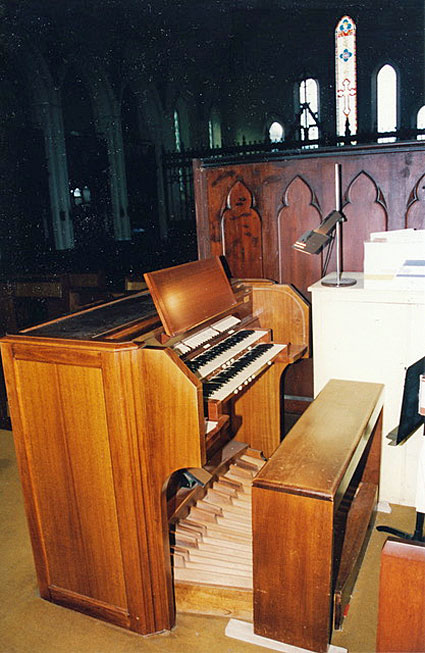
Detached console of the rebuilt organ at St Mark's, Fitzroy
[Photograph by Peter Jewkes (1997)]
It is reported that John Parker, who worked for Hill, Norman and Beard (Aust.), made significant alterations in the late 1970s, converting Anderson's Great Claribella into a Stopped Diapason, and revoicing the Great Twelfth as a Nazard.14
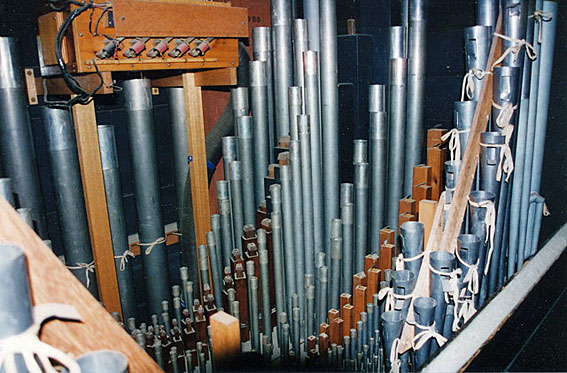
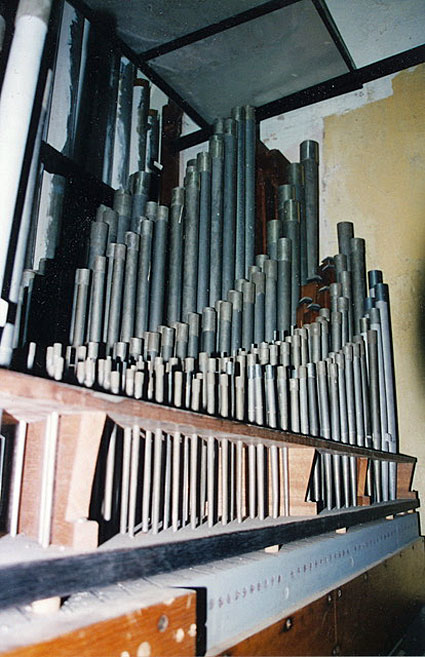
Pipework of the rebuilt organ at St Mark's, Fitzroy
[Photographs by Peter Jewkes (1997)]
Early in 1998, a decision was made by St Mark's to obtain a redundant organ from Cowley, Oxon, UK, rather than rebuilding the existing instrument. The old organ was purchased by St Francis-in-the-Fields Church, and was removed from St Mark's in May 1998. Ian Wakeley of Wakeley Pipe Organs, Chirnside Park, had grown up in the Mooroolbark parish, and oversaw the work of overhauling the instrument.
The installation of the organ at Mooroolbark involved complete rewiring along with the addition of a solid-state key switching system. The composition of the Swell Mixture, which was revoiced to blend with the Anderson pipework, was changed from 19.22.26 to 15.19.22. The Krummhorn unit that had been added to the Pedal Organ in 1963 was discarded and replaced by an upward extension of the Open Diapason 16ft stop to provide Octave 8ft and Super Octave 4ft stops. Anderson's pine casework was stripped back to bare timber and given a natural finish, and the façade pipes were painted gold. The organ was installed at Mooroolbark early in 1999.15
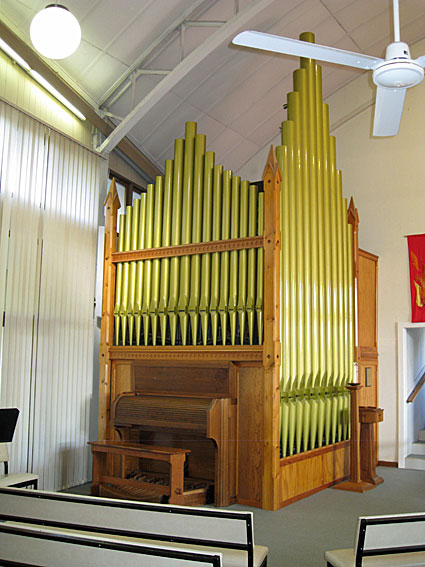
The organ at St Francis-in-the-Fields Anglican Church, Mooroolbark
[Photograph by Geoffrey Cox (September 2017)]
The specification is as follows:
| GREAT ORGAN Open Diapason Stopped Diapason Dulciana Octave [Chimney] Flute Quint [now Nazard] Super Octave Trumpet SWELL ORGAN Open Diapason Stopped Diapason Salicional Principal Octave Mixture Trumpet PEDAL ORGAN Open Diapason Bourdon Octave Flute Super Octave Octave Flute COUPLERS [Swell] Sub Octave [Swell] Unison Off [Swell] Octave Swell Sub Octave to Great Swell to Great Swell Octave to Great Great to Pedal Swell to Pedal Swell Octave to Pedal |
8 8 8 4 4 2-2/3 2 8 8 8 8 4 2 III 8 16 16 8 8 4 4 |
A B B A C A C A C |
[1877] [1877 'Claribella'+'Stopped Diapason' (bass); 1963 'Clarabella'; converted late-1970s] [1877; gvd bass] [1877 'Principal' renamed] [1963; replaced 1877 'Flute'] [1877 'Twelfth' renamed] [1877 'Fifteenth' renamed] [1963] [1877] [1877] [1877 'Keraulophon' renamed] [1877] [1877 'Piccolo' renamed] [replaced 1877 'Hautboy'; composition adjusted 1999] [1963] [12 new bass pipes, 1963] [1877] [1999; replaced 1963 Krummhorn 8ft] [1963] [1999; replaced 1963 Krummhorn 4ft] [1963] [1999] |
Electro-pneumatic action
Detached stop-key console
Balanced Swell pedal (electrically operated; horizontal shutters)
Compass: 61/30
Solid-state key switching system
Swell tremulant [1963; removed 1999?]
3 thumb pistons to Great and Pedal organs
3 thumb pistons to Swell organ
1 thumb piston to Great to Pedal (reversible)
1 thumb piston to Swell to Great (reversible).16
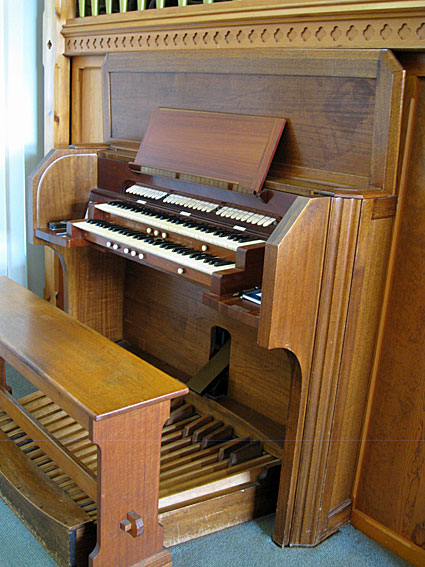
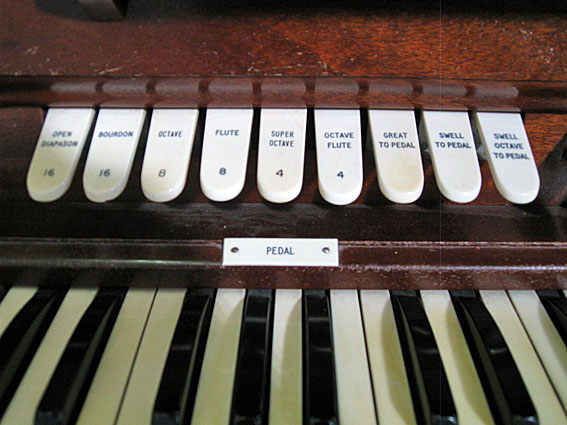
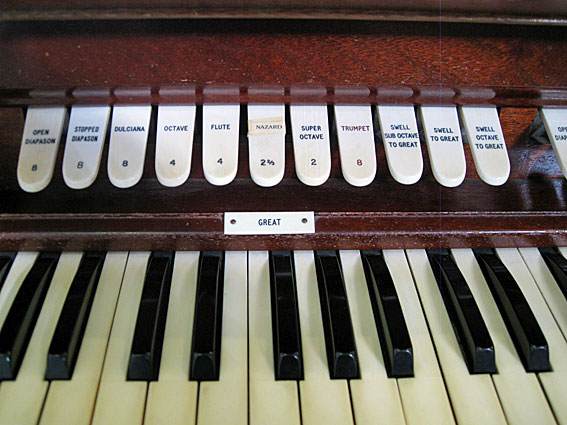
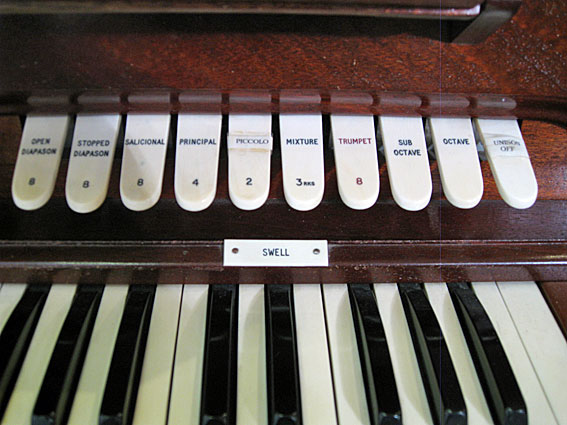
Console details of the organ at Mooroolbark
[Photographs by Geoffrey Cox (September 2017)]
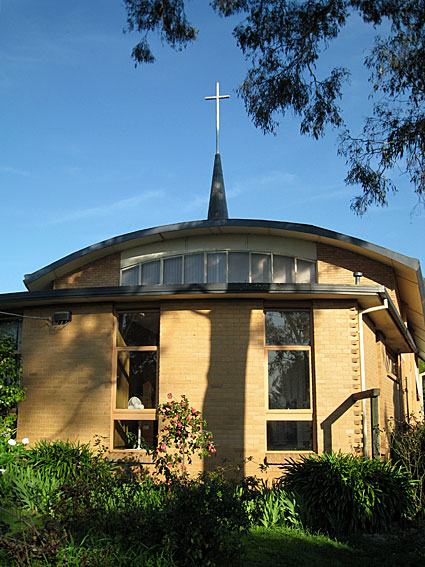
St Francis-in-the-Fields Anglican Church, Mooroolbark
[Photograph by Geoffrey Cox (September 2017)]
_________________________
1. Commemorative stones at the church, and information supplied by Peter Wakeley, September 2017.
2. The Argus (6 November 1877), p. 5; see also The Age (6 November 1877), p. 2; Church of England Messenger (8 November 1877), p. 4.
3. The photograph is undated, and incorrectly captioned 'The organ erected 1855.'
4. George Fincham Letter Book 8, p. 55 (4 January 1892) & Book 9, p. 333 (6 February 1895) – cited in Fincham/Matthews Collection (State Library of Victoria MS 9423).
5. Fincham/Matthews Collection, op. cit., 'Notes,' D14 and D15.
6. George Fincham Letter Book 17, p. 148 (23 July 1900) – cited in Fincham/Matthews Collection, op. cit.
7. E.N. Matthews, Colonial Organs and Organbuilders (Carlton: Melbourne University Press, 1969), p. 87.
8. Church of England Messenger (1 August 1900), pp. 121-22.
9. George Fincham Letter Book 17, p. 179 (8 August 1900) – cited in Fincham/Matthews Collection, op. cit.
10. Souvenir: St Mark's Fitzroy, 1853-1923 (brochure, Aug 1923), p. 20.
11. Hill Norman & Beard (Aust.) Pty Ltd, Estimate and Specification Covering the Rebuilding of the Organ at St Mark's Church of England, Fitzroy (13th February 1963) - State Library of Victoria: St Mark's Church, Fitzroy: Records, 1847-1982 (MS 11391), Box 1959/15.
12. The Age (15 November 1963).
13. Details derived from: Peter Wakeley, 'A successful organ transplant,' Organo Pleno, vol. 1, no. 5 (October 1999), pp. 17-18; specification noted 1965 by John Maidment; and Hill Norman & Beard (Aust.) Pty Ltd, Estimate, op. cit.
14. Wakeley, op. cit., p. 17.
15. Loc. cit.
16. Specification noted by G. Cox, September 2017. Historic details derived from the sources cited above.